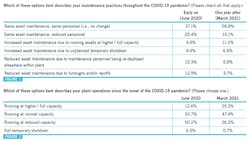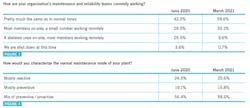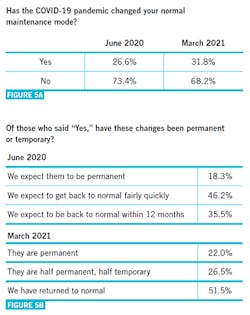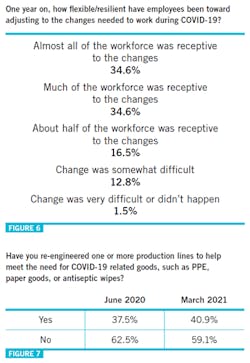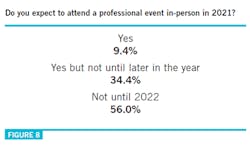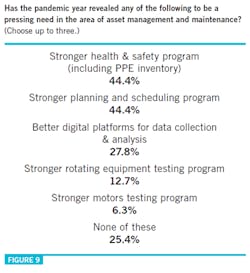2021 COVID-19 impact survey: What's changed for maintenance and what's stayed the same
What a difference a year makes.
At this time last year, many people were under shelter-in-place orders to help prevent the spread of the novel coronavirus. Health and safety protocols for essential workers changed virtually overnight, and plant shutdowns were common. Maintenance workers who knew their way around a thermal camera suddenly were finding themselves stationed at plant entrances, taking the temperature of arriving workers.
Now, as of early April, more than 40% of the eligible population 16 and older in the U.S. has received at least one dose of a COVID-19 vaccine. And, while factory employment is 4% below pre-pandemic levels, manufacturing activity in the U.S. has just hit its highest level in 37 years. Some reports indicate that activity levels could have been higher, but the search continues for qualified workers to fill open skilled positions.
At the start of this year, the Plant Services editors decided to take one final look back at the pandemic year, and take a snapshot of the new normal that is emerging from this moment of crisis. Our first survey on this topic captured a slice of time during the middle of the crisis (http://plnt.sv/COVID-2020). This new survey was conducted in February and March 2021, and generated more than 140 responses.
We thank everyone who took the time to share their thoughts via the survey, and are pleased to share the results with you from then and now. With any luck, the worst of the hiccups from the pandemic are behind us, and they are rapidly being absorbed by industry as simply a set of new best practices.
1. Operational changes
Taken together, the two charts in Figures 1 and 2 tell a tale of recovery in the manufacturing sector. Last June, plants were in the middle of making tough choices about how to best deploy their personnel, and how many people they could afford to keep.
Only about 1 in 3 respondents could say that there were no changes to their regular asset maintenance workload and headcount, and 13% of respondents admitted that they were reducing available maintenance resources due to furloughs and/or layoffs. To make matters worse, fully half of respondents last June said their plants were running at reduced capacity, and 6.5% said they were experiencing a full temporary shutdown.
Again, what a difference a year makes. More than 25% of respondents claim they are currently operating at higher / full capacity, and only one person said they were still under a full shutdown. On the maintenance side, nearly 3 in 5 respondents can now say they are back to their pre-COVID maintenance and headcount levels, and 11% are reporting increased asset maintenance due to running assets at higher or full capacity.
2. Changes in maintenance modes
For the survey questions that took a deeper dive into maintenance practices then and now, a similar picture emerges. Nearly 3 in 5 respondents tell us they are now back to running pretty much the same as they were in pre-COVID days (see Figure 3), and maintenance modes are trending slightly away from preventive, with a slight rise reported for both reactive and more proactive modes (Figure 4).
These results suggest that disruptions caused by the pandemic provided many maintenance teams with the opportunity to change their practices, with 26% of respondents noting this opportunity last June, and 32% of respondents admitting in March that changes had taken place (see Figure 5). It’s also interesting to note that a year ago, nearly half of respondents thought we’d get back to normal fairly quickly. Now, with 12 months of hindsight, just over half of respondents say that it has taken a year to return to normal.
3. Plant agility
The questions in this section were a mixed bag, designed to evaluate the level of flexibility among plant teams during the pandemic, from operations to professional development. Figure 6 uncovered a very high level of resilience among plant workers, as 7 in 10 respondents said that most or all of their teammates were receptive to necessary changes in routine and production. And the data in Figure 7 make it clear that more than 40% of respondents were actively re-engineering production lines to meet the immediate needs of the market during the height of the pandemic.
Finally, Figure 8 asked about the next time people would be able to travel and see each other again at professional events. It may be a while before we all are able to see each other again at an event, but I’m thrilled to note that almost half of you are looking forward to attending at least one event before the end of 2021.
4. Pressing needs
The final questions on the survey asked about the needs that the COVID-19 pandemic had revealed, both in the areas of asset management and in human resources. In my opinion, these data point to the most revealing change of the pandemic: the change away from seeking out full-time proactive maintenance experts, and toward building stronger partnerships with service providers.
Starting with the data in Figure 9, it was interesting that, when it comes to needs in the area of asset management, the data points barely moved between June 2020 and March 2021. A vast majority of respondents indicated that they needed both a stronger health and safety program and a stronger planning and scheduling program.
However, it is the data in Figure 10 that point to a new post-crisis emphasis on bringing contractors on-board to help fill maintenance resourcing gaps. This trend matches what the Plant Services editors have observed in general when it comes to how organizations are overcoming the industrial skills gap. Taken in the immediate context of other data from this survey, it also seems clear that renewed levels of production are also driving plant teams to fill headcount needs quickly.
Bringing contractors on-board also leaves plants with room to maneuver if production levels change again quickly. After all, thanks to COVID-19, we all have a new appreciation for how rapidly drastic change can be forced upon us.

